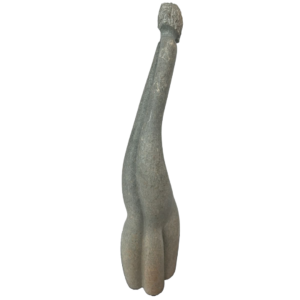Apart from his father, a great source of inspiration for Richard is the very society he lives in. His works often portray the relationships and events within an ordinary society. The relationships can be between lovers, man to woman, mother to child, friends, siblings, neighbours etc. Richards work thus mirrors the society through stone.
A famous African writer Okot PBitele in his essay Artist the Ruler remarked that any work of art should have a purpose and it is also of paramount importance that every work of art be original and show signs of creativity. The artist has power in a society and it is to this hypothesis that Richards work subscribes. Art is different from mass production in say the manufacturing industry in that it thrives on originality, creativity and uniqueness as seen in Richards work.
Born Richard Rosani in Harare then Salisbury in 1967, to parents Amidu and Fainesi Rosani, he was the first child in a family of six. He grew up in Old Tafara with the rest of his family as a young boy attending school at Tafara Primary, he excelled during drawing lessons despite the fact that little emphasis was placed on art as a subject. He studied art amongst his fellow students because of his exceptional talent at drawing which was God-given. Often, he would stay behind in class drawing illustration charts upon teachers requests while his classmates were out in the school grounds.
This image of being the odd one lives with him to the present day in his career. To many people Richard is regarded as the bad boy of the local sculpting fraternity because he rarely associates with fellow sculptors. However, it should not be very surprising when one remembers that his mentor was the late Nicholas mukombernawa. Nicholas, a great sculptor of our time, is well known to have remarked that artists should not work in groups as this destroys originality and promotes copying.
To show that Richard was marked for bigger things in life, he was part of a group of students who produced a paper mach rhino that went on to win the National Gallery Schools Art Competition. This was during his primary school years. In High School at Mabvuku High his talent continued to set him apart from the other students.
He initially trained as a fashion designer in 1985 but his passion drove him to sculpture. He joined other artists at Silveira House (Catholic Mission) near Tafara and became a founder member of Gota Redisuma also based at Silveira House where they hoped to train and develop upcoming sculptors and other artists. Silveira House Catholic Training Centre is now being used by Art Peace, which he also co-founded.
In 1987, Richard was honoured to have the chance of working with Nicholas Mukomberanwa at his Ruwa farm. Nicholas was his mentor but this has not prompted Richard to copy him, as some sculptors would do. The year 1989 saw Richard moving to gallery 2000 where he was a resident artist.
From 1996 to 1998, he was a resident artist at Chapungu sculpture park and then moved away to work from home (Tafara)) which is his current workplace. Over the years, he has managed to develop and perfect his own distinct style synonymous with only himself. Breaking away from rigid institutions has tremendously helped the development of this rich style. A distinctive feature of his work is the unique lines, which not only beautify the pieces but also serve to protect the originality of the artists work. Imitators of his work can not produce these lines with the same effect. Those familiar with Richards work can easily detect imitations from original pieces.
Earlier in 1992 he was awarded a Certificate Of Excellence by the National Gallery Of Zimbabwe and in the following year one of his pieces was highly commended by the National Gallery of Zimbabwe. It is worth remembering that these achievements and association with the National Gallery date back to his days at Tafara School, when they won the Schools Competition.
The success story has not only been confined within Zimbabwes borders, as the artist has held a number of successful exhibitions abroad. In 1993 and 1995 Richard held exhibitions in England and the United States Of America respectively. The exhibitions saw Richard commanding a large following of admirers and buyers alike; exhibitions in Austria, Germany, Belgium, Holland, France, Italy and neighbouring South Africa were equally successful.
Despite these achievements the artist shires away from publicity, which he believes should not be coveted for. This shows that he is a humble person. He is not happy with some practices within the field, which include fixed attention on certain sculptors by the media and some promoters at the expense of the rest of the marginalized sculptors. The creation of cliques of artists by the dealers irks him so much, as it deprives the general public of a wider range of work and artists who are even more talented.



